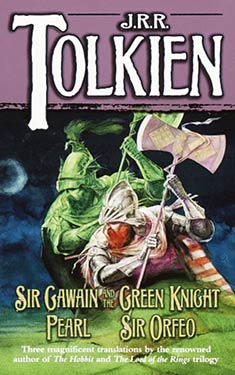JRR Tolkien
Completed 11/5/2023, Reviewed 11/5/2023
4 stars
I’ve never had much of a fondness for poetry. I was usually too caught up in the mechanics to understand or appreciate the story, emotion, or sentiment. That changed when I began to read Tolkien’s poetry. For some reason, I got it. This book is a collection of 14th – 15th century poetry that Tolkien studied and translated into modern English, keeping the form of the originals as close as possible. The result in the case of Sir Gawain and the Green Knight is a phenomenal alliterative tale of morality and courtesy in Arthur’s Court. Pearl is a dream-like fantasy of ABAB poetry, and Sir Orfeo is a variation of Orpheus and Eurydice again in ABAB style. I enjoyed them in varying degrees.
For the most part I enjoyed Sir Gawain’s tale. I find alliterative poetry a little tough to get into, but generally can get used to it after about ten or so pages of it. Alliterative means that there is a recurring sound in the line. For example, “Attend the tale of Sweeny Todd” has three T’s. When each line is like that, I find myself looking for the recurring sound rather than paying attention to the story. But I did get into the story, which is basically a morality play.
Sir Gawain, the nephew of Kind Arthur, takes a challenge to fight the mysterious Green Knight in a one-stoke only game. Gawain gets the first stroke, with the Green Knight’s return stroke coming a year later. Thinking he’ll kill the Green Knight, he cuts off his head, but the Green Knight gets up, takes his head and rides off. Now Gawain is bound to find the Knight to let him have the return stroke. During the interim year, the young knight ends up in a castle where the lord engages him in another game of gift giving and chastity.
I found it strange the Gawain naively takes up these games without thinking of the catches, but was able to suspend disbelief to enjoy the story. The only real hindrance to my enjoyment was the somewhat archaic structure of the poetry, with subject, verb, object being bounced all over a line. Like Shakespeare, you get it after a while, but it occasionally made it difficult to follow.
Sir Orfeo was a cakewalk by comparison. He is a king with a queen who is stolen by fairies. He goes into a self-imposed exile to mourn her disappearance only to find a secret way into the faerie realm to bring her back. It was very easy to follow the story, which is short and to the point. Gawain on the other hand is nearly one hundred pages long.
I didn’t enjoy Pearl at all. It a story about a man mourning a deceased child. He dreams she returns to him in a dream, appearing from heaven. The narrator then sees images derived from John’s Apocalypse and David’s Psalms. Mixing religious symbols in a dream state with poetic form made for tough reading. If Christopher Tolkien didn’t have a forward to this piece, I would have been totally lost. I felt this story was a blemish to an otherwise very good example of the erudite poetry that Tolkien excelled at.
I give the book four stars out of five on the strength of Sir Gawain and Sir Orfeo. The translations from middle English to contemporary poetry keeping the flavor and form of the original and still be able to tell a comprehensible story amazes me. From other reviews, I heard that listening to the audio book is not as enjoyable, which makes sense. I would think it would be much easier to read and listen to the poems at the same time. Anyway, I’m glad I finally read this book, which had been sitting on my Kindle for a few years. Hopefully next year, I’ll read another one of his translation books. There are still one or two out there which I haven’t read yet.

No comments:
Post a Comment